The winner of Countess of Scandal is…Caroline Storer! Please send your snail mail address to laurelmckee7551@yahoo.com to claim your prize….

The winner of Countess of Scandal is…Caroline Storer! Please send your snail mail address to laurelmckee7551@yahoo.com to claim your prize….
 One thing I love about February around here is that it’s big book sale month! There are 3 library sales (one is HUGE), and a couple private schools (which also include bake sales, yum). I always find treasures at these sales (even if they’re just treasures to me!), and it’s so much fun to dig around on the tables and in boxes, never knowing what’s going to show up. I already hit one sale last weekend, and found almost a complete set of Will Durant’s Story of Civilization (for $1 a volume!), stuff like The Civilization of Europe in the Renaissance and Life in Medieval France, as well as oddities like an intriguing memoir called Love is a Mix Tape, a book of watercolors of Louisiana plantation houses from the 1950s, and some Heyer hardbacks in like-new condition. And this isn’t even the BIG library sale (which is on February 20).
One thing I love about February around here is that it’s big book sale month! There are 3 library sales (one is HUGE), and a couple private schools (which also include bake sales, yum). I always find treasures at these sales (even if they’re just treasures to me!), and it’s so much fun to dig around on the tables and in boxes, never knowing what’s going to show up. I already hit one sale last weekend, and found almost a complete set of Will Durant’s Story of Civilization (for $1 a volume!), stuff like The Civilization of Europe in the Renaissance and Life in Medieval France, as well as oddities like an intriguing memoir called Love is a Mix Tape, a book of watercolors of Louisiana plantation houses from the 1950s, and some Heyer hardbacks in like-new condition. And this isn’t even the BIG library sale (which is on February 20).
 I also like February because it’s Valentine’s Day, which means more stuff about romance novels in papers and magazines, and lots and lots of chocolate in the stores. It’s also release month for me this year, and not just Countess of Scandal! If you’re in the UK, Harlequin is releasing my Renaissance Trilogy in their “Super Historical” line, starting this month with A Notorious Woman. See more about it here…
I also like February because it’s Valentine’s Day, which means more stuff about romance novels in papers and magazines, and lots and lots of chocolate in the stores. It’s also release month for me this year, and not just Countess of Scandal! If you’re in the UK, Harlequin is releasing my Renaissance Trilogy in their “Super Historical” line, starting this month with A Notorious Woman. See more about it here…
And yesterday marks the birthday of actor John Philip Kemble, scion of the famous theatrical family and brother of Sarah Siddons! I’ve been fiddling about with a Georgian theater story myself, and thus reading lots about the subject, so this was a nice find. (And thanks to Elena for recommending the book Fashionable Acts! It’s great).
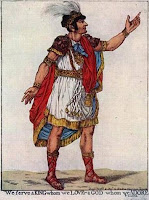 John Philip Kemble was born February 1, 1757 at Prescot in Lancashire, the second child of actor-manager Roger Kemble. His mother was Catholic, and thus he was educated at the Sedgley Park Catholic seminary, and at the English college at Douai, with the expectation that he would become a priest. He found he had no vocation, though, and returned to England to join the theatrical company of Crump and Chamberlain, debuting as the title role of Theodosius at Wolverhampton on January 8, 1776. In 1778 he joined the York company of Tate Wilkinson, making a splash in roles like “Wakefield” in The Recruiting Officer, Macbeth (in Hull on October 30), and in York as “Orestes” in Distresset Mother. In 1781 he obtained a “star” engagement in Dublin, appearing there as Hamlet in November. He was a big hit in Ireland, as Hamlet, Raymond in The Count of Narbonne (a play from Castle of Otranto).
John Philip Kemble was born February 1, 1757 at Prescot in Lancashire, the second child of actor-manager Roger Kemble. His mother was Catholic, and thus he was educated at the Sedgley Park Catholic seminary, and at the English college at Douai, with the expectation that he would become a priest. He found he had no vocation, though, and returned to England to join the theatrical company of Crump and Chamberlain, debuting as the title role of Theodosius at Wolverhampton on January 8, 1776. In 1778 he joined the York company of Tate Wilkinson, making a splash in roles like “Wakefield” in The Recruiting Officer, Macbeth (in Hull on October 30), and in York as “Orestes” in Distresset Mother. In 1781 he obtained a “star” engagement in Dublin, appearing there as Hamlet in November. He was a big hit in Ireland, as Hamlet, Raymond in The Count of Narbonne (a play from Castle of Otranto).
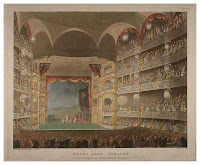 By 1783 his acclaim, along with the immense fame of his sister Mrs. Siddons, landed him an engagement at the Theatre Royal, Drury Lane, where he debuted as Hamlet on September 30. His greatest role there was Macbeth, and he also got rave reviews opposite his sister in Edward Moore’s The Gamester. They went on to play together in numerous productions, including Othello, Julia, The Carmelite, and Kemble own adaptation of Philip Massinger’s A Maid of Honor. In 1787 he married the actress (and widow of an actor) Priscilla Hopkins Brereton, and soon after was appointed manager of Drury Lane, which gave him the opportunity to indulge his own vision of the plays they presented (and to take whatever parts he fancied, including a wide variety of Shakespearean characters). He resigned this position in 1802, and in 1803 became manager of the Theatre Royal, Covent Garden (which he had bough a sixth share in for a high price). The theater burned in September 1808, and the rise in ticket prices after its re-opening led to the Old Price Riots, which suspended performances for over 3 months and nearly ruined Kemble financially (he was saved by a loan, later made a gift, of 10,000 pounds by the Duke of Cumberland). He retired from the stage after a last performance of his best-known role, Coriolanus, in 1817. He died in Lausanne in 1823.
By 1783 his acclaim, along with the immense fame of his sister Mrs. Siddons, landed him an engagement at the Theatre Royal, Drury Lane, where he debuted as Hamlet on September 30. His greatest role there was Macbeth, and he also got rave reviews opposite his sister in Edward Moore’s The Gamester. They went on to play together in numerous productions, including Othello, Julia, The Carmelite, and Kemble own adaptation of Philip Massinger’s A Maid of Honor. In 1787 he married the actress (and widow of an actor) Priscilla Hopkins Brereton, and soon after was appointed manager of Drury Lane, which gave him the opportunity to indulge his own vision of the plays they presented (and to take whatever parts he fancied, including a wide variety of Shakespearean characters). He resigned this position in 1802, and in 1803 became manager of the Theatre Royal, Covent Garden (which he had bough a sixth share in for a high price). The theater burned in September 1808, and the rise in ticket prices after its re-opening led to the Old Price Riots, which suspended performances for over 3 months and nearly ruined Kemble financially (he was saved by a loan, later made a gift, of 10,000 pounds by the Duke of Cumberland). He retired from the stage after a last performance of his best-known role, Coriolanus, in 1817. He died in Lausanne in 1823.
 In 1785, the critic Richard Sharp wrote to his friend, the actor John Henderson, after viewing a performance by Kemble: “I went, as promised to see the new ‘Hamlet,’ whose provincial fame had excited your curiosity as well as mine…yet Nature, though she has been bountiful to him in figure and feature, has denied him a voice; of course he could not exemplify his own direction for the players to ‘speak the speech trippingly on the tongue,’ and now and then he was as deliberate in his delivery as if he had been reading prayers and had waited for the response. He is a very handsome man, almost tall and almost large, with features of a sensible but fixed and tragic cast; his action is graceful, though somewhat formal, which you will find it hard to believe yet it is true. Very careful study appears in all he says and all he does; but there is more singularity and ingenuity than simplicity and fire.”
In 1785, the critic Richard Sharp wrote to his friend, the actor John Henderson, after viewing a performance by Kemble: “I went, as promised to see the new ‘Hamlet,’ whose provincial fame had excited your curiosity as well as mine…yet Nature, though she has been bountiful to him in figure and feature, has denied him a voice; of course he could not exemplify his own direction for the players to ‘speak the speech trippingly on the tongue,’ and now and then he was as deliberate in his delivery as if he had been reading prayers and had waited for the response. He is a very handsome man, almost tall and almost large, with features of a sensible but fixed and tragic cast; his action is graceful, though somewhat formal, which you will find it hard to believe yet it is true. Very careful study appears in all he says and all he does; but there is more singularity and ingenuity than simplicity and fire.”
Some sources for this post I found were:
Herschel Baker, John Philip Kemble: The Actor in His Theater
Linda Kelly, The Kemble Era: John Philip Kemble, Sarah Siddons and the London Stage
(And a book I really like, but which is about John Philip Kemble’s great-niece, a stage star in her own right who married an American plantation owner: Fanny Kemble’s Civil Wars, by Catherine Clinton)
What have been some of your best book sale finds?? Seen any good plays lately?
As promised, we have three winners from Michelle’s visit!
An Accidental Seduction–Jane Austen!
Accidental Countess–Daphne!
Accidental Princess–Keira Soleore!
Please send your snail mail address to us at riskies@yahoo.com, and congrats!
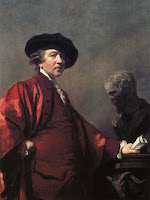 In looking around for a blog topic for today (I was feeling especially lazy, having just finished revisions and spending waaaay too much time watching the Olympics!), I found out one of the preeminent Georgian portrait artists, Sir Joshua Reynolds, died on this day in 1792 at the age of 69. I love Reynolds’s work whenever I’m lucky enough to see one on a museum visit, and enjoyed taking a closer look at his life! (Also today marks the anniversary of the death of Keats–I have a small tribute to him on my own blog, and I did a post on his death here at the Riskies a couple of years ago)
In looking around for a blog topic for today (I was feeling especially lazy, having just finished revisions and spending waaaay too much time watching the Olympics!), I found out one of the preeminent Georgian portrait artists, Sir Joshua Reynolds, died on this day in 1792 at the age of 69. I love Reynolds’s work whenever I’m lucky enough to see one on a museum visit, and enjoyed taking a closer look at his life! (Also today marks the anniversary of the death of Keats–I have a small tribute to him on my own blog, and I did a post on his death here at the Riskies a couple of years ago)
Reynolds was born on July 16, 1723 in Devon, one of 11 children of a village schoolmaster and clergyman. He showed an interest in art early on, and was apprenticed in 1740 to fashionable portraitist Thomas Hudson, where he stayed for 3 years. From 1749 to 1752, he studied the Old Masters in Italy and had a grand time, but sadly also caught a bad cold that left him partially deaf (in his self-portraits, he’s often seen with his ubiquitous ear trumpet). For the rest of his life he lived in London, rarely even taking a holiday from his studio. But he was never lonely–he was a sociable man with a wide and intellectual circle of friends such as Samuel Johnson, Oliver Goldsmith, David Garrick, Angelica Kauffmann, the Thrales, Edmund Burke, etc. He was one of the founders and the first president of the Royal Academy, an early member of the Royal Society of Arts, and a founder of the Society of Artists. He was knighted by George III in 1769. And yet he still had time to paint an estimated 3000 portraits (for which he could command between 80 and 100 guineas). He was well-known for his dynamic and life-like scenes.
Reynolds never married, though he had reputation as a nice and laid-back (though not very handsome!) man. His sister kept house for him and he seems to have been rather close to his family. There were rumors of liaisons with some of his artistic subjects, such as Nelly O’Brien and the actress Kitty Fisher, but nothing was ever proved. Boswell (who dedicated his Life of Samuel Johnson to Reynolds) stated, “He said the reason he would never marry was that every woman whom he liked had grown indifferent to him, and he had been glad he did not marry her.” He died in 1792 at his house in Leicester Fields in London and was buried in St. Paul’s Cathedral. A good resource about his life is Martin Postle’s Joshua Reynolds: The Creation of Celebrity (2005) and numerous art history volumes. A good source for discussion on his art can be found here. Here are just a few of his many, many Society and demi-monde portraits:
 Georgiana, Duchess of Devonshire, and her daughter
Georgiana, Duchess of Devonshire, and her daughter
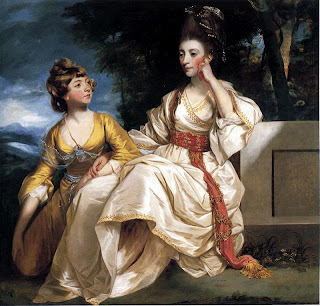 Johnson’s friend Hester Thrale and her daughter
Johnson’s friend Hester Thrale and her daughter
What is your favorite Reynolds portrait, or favorite historical artist? I’ve often thought it would be fun to dress up and have my portrait painted like one of these–what would you wear for your own portrait???
“A keen sense of the era and delightful characters that keep readers coming back for more!” –RT Book Reviews on An Accidental Countess

The Riskies are happy to welcome back Michelle Willingham, to talk to us about her new direction–into the Victorian era! We’ll have three winners this weekend, as Michelle is giving away copies of The Accidental Countess, The Accidental Princess, and a free download of her Undone story An Accidental Seduction!
Riskies: Welcome back, Michelle! You have your Victorian hat on this time. Tell us about your new series…
 Michelle: Every author has a “book of her heart,” and for me that was The Accidental Countess! I kept beating down publisher’s doors, trying to sell my first Irish medieval, and in the meantime I wrote a more traditional setting of Victorian England. So The Accidental Countess was technically the second book I ever wrote. I kept trying to sell it, but the heroine was a little too “snarky” for many folks. She was a joy to write, and how often do you get a heroine who considers poisoning the hero on the first page because he forgot he was married to her? I had far too much fun. I wrote it for myself and didn’t worry about the rules. I simply wanted to be entertained. I didn’t have a clue who the villain was until the last chapter, and I think that made the suspense plot believable. It took me selling another 4 books before I offered Countess to Harlequin, and even then my editor wanted to hold off on the release date. She asked me to write a connecting book which became The Accidental Princess. I knew the heroine of Countess had a sister, but she was off at finishing school and I didn’t know much about her. I decided to do a secret royalty story, along the lines of a Gothic romance. I wanted a true fairy tale with a possible prince and a woman who was trapped in the rigid life of a Victorian lady. Since neither heroine ever dreamed she would become a Princess or a Countess, that’s how the “Accidental” part was born!
Michelle: Every author has a “book of her heart,” and for me that was The Accidental Countess! I kept beating down publisher’s doors, trying to sell my first Irish medieval, and in the meantime I wrote a more traditional setting of Victorian England. So The Accidental Countess was technically the second book I ever wrote. I kept trying to sell it, but the heroine was a little too “snarky” for many folks. She was a joy to write, and how often do you get a heroine who considers poisoning the hero on the first page because he forgot he was married to her? I had far too much fun. I wrote it for myself and didn’t worry about the rules. I simply wanted to be entertained. I didn’t have a clue who the villain was until the last chapter, and I think that made the suspense plot believable. It took me selling another 4 books before I offered Countess to Harlequin, and even then my editor wanted to hold off on the release date. She asked me to write a connecting book which became The Accidental Princess. I knew the heroine of Countess had a sister, but she was off at finishing school and I didn’t know much about her. I decided to do a secret royalty story, along the lines of a Gothic romance. I wanted a true fairy tale with a possible prince and a woman who was trapped in the rigid life of a Victorian lady. Since neither heroine ever dreamed she would become a Princess or a Countess, that’s how the “Accidental” part was born!
 Last, my editor wanted me to write a connected novella for the Harlequin Historical Undone line. I ended up writing a prequel, telling how the hero and heroine in Countess actually got married, and that was the story of An Accidental Seduction. The novella has its own happy ending, but then Countess starts about 3 months later, and their marriage is tested to the limit…
Last, my editor wanted me to write a connected novella for the Harlequin Historical Undone line. I ended up writing a prequel, telling how the hero and heroine in Countess actually got married, and that was the story of An Accidental Seduction. The novella has its own happy ending, but then Countess starts about 3 months later, and their marriage is tested to the limit…
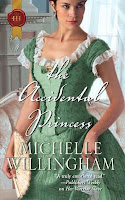 Riskies: What was the inspiration for these books?
Riskies: What was the inspiration for these books?
Michelle: The Accidental Countess reminds me a bit of The Bourne Identity with a hero who doesn’t know what happened during 3 months of his life. Unfortunately, he happened to elope during that period, and he remembers nothing about his wife! The story is about falling in love all over again. The Accidental Princess was inspired by all the Victoria Holt fairytale romances I read as a teenager, and it’s a Cinderella reversal where the hero is a common soldier who may or may not be a prince. I was able to incorporate elements of Titanic with the developing romance continuing on board a steam ship bound for Germany. I loved researching the interiors of Victorian steam ships, and they were incredibly luxurious with chandeliers, ballrooms, and promenade decks.
Riskies: I love the recipes on your website! (especially the yummy-sounding sugar gingerbread). How does that fit into the story?
 Michelle: The heroine of Countess is a Cinderella figure whose family suffered through poverty, and she had to cook for the family in order to survive. In the book, I wanted to include some of Emily’s recipes, so I consulted some historical cookbooks, made some of my own changes, and tested some of the recipes. It was fun, and I ended up finding a favorite gingerbread recipe for Christmas as a result! Technically the title is “Molasses Cookies” but there’s a tablespoon of ginger in the recipe, so that makes it a perfect gingerbread cookie dough. The recipes are here on my website!
Michelle: The heroine of Countess is a Cinderella figure whose family suffered through poverty, and she had to cook for the family in order to survive. In the book, I wanted to include some of Emily’s recipes, so I consulted some historical cookbooks, made some of my own changes, and tested some of the recipes. It was fun, and I ended up finding a favorite gingerbread recipe for Christmas as a result! Technically the title is “Molasses Cookies” but there’s a tablespoon of ginger in the recipe, so that makes it a perfect gingerbread cookie dough. The recipes are here on my website!
Riskies: What other research did you have to do? Was it a challenge to change gears from the Medieval era to the Victorian?
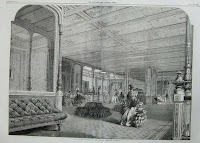 Michelle: The etiquette and clothing of Victorian England are completely different from Medieval times! Also, I found the pacing of the romance was very different–more subtle, but it could definitely be scandalous in its own way! Out of all the research I really enjoyed learning about steam ships the most (used in The Accidental Princess). I visited the Mariner’s Museum in Newport News, Virginia and asked for primary source photographs of ships from 1855. I used The Great Eastern ship as a model for my boat. Although my ship was only traveling from London to Bremerhaven, in my mind it could also make transatlantic voyages. Okay, so there was a little creative license there, but I wanted the more luxurious interiors!
Michelle: The etiquette and clothing of Victorian England are completely different from Medieval times! Also, I found the pacing of the romance was very different–more subtle, but it could definitely be scandalous in its own way! Out of all the research I really enjoyed learning about steam ships the most (used in The Accidental Princess). I visited the Mariner’s Museum in Newport News, Virginia and asked for primary source photographs of ships from 1855. I used The Great Eastern ship as a model for my boat. Although my ship was only traveling from London to Bremerhaven, in my mind it could also make transatlantic voyages. Okay, so there was a little creative license there, but I wanted the more luxurious interiors!
Riskies: These covers are gorgeous! Do they reflect the stories?
Michelle: It’s a good thing I have nothing to do with covers because otherwise there would be stick people on the front! Princess is probably my favorite of the 3, because the heroine truly is a strong woman. I love the expression on her face, as though she’s already behaving like a princess. Countess had a bit of controversy surrounding the cover. Originally, the woman was lifting her skirt and baring her stocking. The art department ended up nixing the scandalous leg, and I’m glad. I like the gorgeous dresses! Overall, I would say they’re a good representation of the stories.
Riskies: What’s next for you?
Michelle: In September this year, my last book in the MacEgan Brothers miniseries will be published. Surrender to the Irish Warrior tells the story of Trahern MacEgan, and it was the most challenging book I’ve ever written. The heroine is the survivor of a brutal tragedy, and the two of them have to heal their broken lives and find love in each other. It took a lot of emotional energy out of me, but in the end I think it came out well.
Thanks so much for letting me visit again! I’d like to offer 3 prizes today–a free download of An Accidental Seduction, and signed copies of The Accidental Princess and The Accidental Countess. For a chance to win, just post a comment or a question and tell me what’s your favorite fairytale?